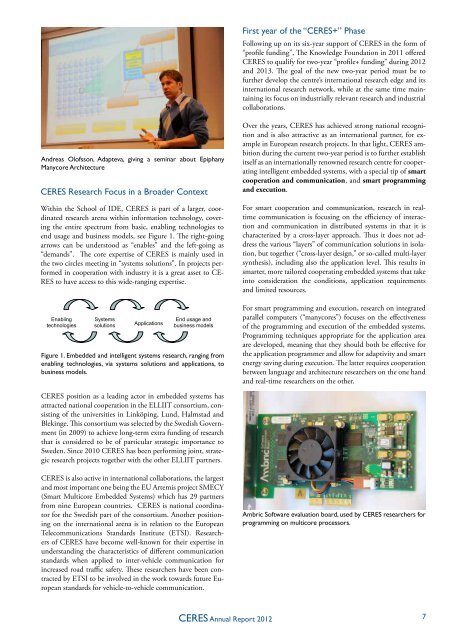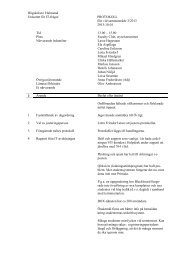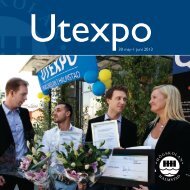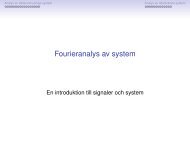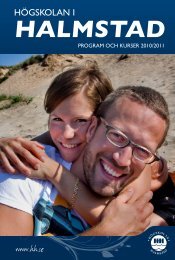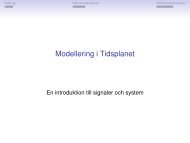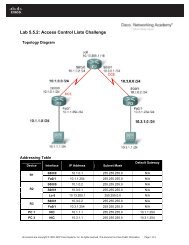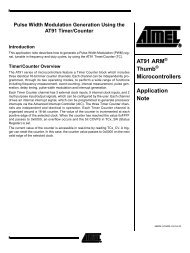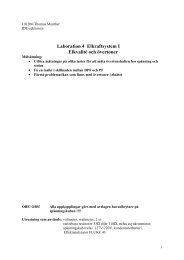ANNUAL REPORT 2012
ANNUAL REPORT 2012
ANNUAL REPORT 2012
Create successful ePaper yourself
Turn your PDF publications into a flip-book with our unique Google optimized e-Paper software.
First year of the “CERES+” Phase<br />
Following up on its six-year support of CERES in the form of<br />
“profile funding”, The Knowledge Foundation in 2011 offered<br />
CERES to qualify for two-year “profile+ funding” during <strong>2012</strong><br />
and 2013. The goal of the new two-year period must be to<br />
further develop the centre’s international research edge and its<br />
international research network, while at the same time maintaining<br />
its focus on industrially relevant research and industrial<br />
collaborations.<br />
Andreas Olofsson, Adapteva, giving a seminar about Epiphany<br />
Manycore Architecture<br />
CERES Research Focus in a Broader Context<br />
Within the School of IDE, CERES is part of a larger, coordinated<br />
research arena within information technology, covering<br />
the entire spectrum from basic, enabling technologies to<br />
end usage and business models, see Figure 1. The right-going<br />
arrows can be understood as “enables” and the left-going as<br />
“demands”. The core expertise of CERES is mainly used in<br />
the two circles meeting in “systems solutions”. In projects performed<br />
in cooperation with industry it is a great asset to CE-<br />
RES to have access to this wide-ranging expertise.<br />
Enabling<br />
technologies<br />
Systems<br />
solutions<br />
Applications<br />
End usage and<br />
business models<br />
Figure 1. Embedded and intelligent systems research, ranging from<br />
enabling technologies, via systems solutions and applications, to<br />
business models.<br />
Over the years, CERES has achieved strong national recognition<br />
and is also attractive as an international partner, for example<br />
in European research projects. In that light, CERES ambition<br />
during the current two-year period is to further establish<br />
itself as an internationally renowned research centre for cooperating<br />
intelligent embedded systems, with a special tip of smart<br />
cooperation and communication, and smart programming<br />
and execution.<br />
For smart cooperation and communication, research in realtime<br />
communication is focusing on the efficiency of interaction<br />
and communication in distributed systems in that it is<br />
characterized by a cross-layer approach. Thus it does not address<br />
the various “layers” of communication solutions in isolation,<br />
but together (“cross-layer design,” or so-called multi-layer<br />
synthesis), including also the application level. This results in<br />
smarter, more tailored cooperating embedded systems that take<br />
into consideration the conditions, application requirements<br />
and limited resources.<br />
For smart programming and execution, research on integrated<br />
parallel computers (“manycores”) focuses on the effectiveness<br />
of the programming and execution of the embedded systems.<br />
Programming techniques appropriate for the application area<br />
are developed, meaning that they should both be effective for<br />
the application programmer and allow for adaptivity and smart<br />
energy saving during execution. The latter requires cooperation<br />
between language and architecture researchers on the one hand<br />
and real-time researchers on the other.<br />
CERES position as a leading actor in embedded systems has<br />
attracted national cooperation in the ELLIIT consortium, consisting<br />
of the universities in Linköping, Lund, Halmstad and<br />
Blekinge. This consortium was selected by the Swedish Government<br />
(in 2009) to achieve long-term extra funding of research<br />
that is considered to be of particular strategic importance to<br />
Sweden. Since 2010 CERES has been performing joint, strategic<br />
research projects together with the other ELLIIT partners.<br />
CERES is also active in international collaborations, the largest<br />
and most important one being the EU Artemis project SMECY<br />
(Smart Multicore Embedded Systems) which has 29 partners<br />
from nine European countries. CERES is national coordinator<br />
for the Swedish part of the consortium. Another positioning<br />
on the international arena is in relation to the European<br />
Telecommunications Standards Institute (ETSI). Researchers<br />
of CERES have become well-known for their expertise in<br />
understanding the characteristics of different communication<br />
standards when applied to inter-vehicle communication for<br />
increased road traffic safety. These researchers have been contracted<br />
by ETSI to be involved in the work towards future European<br />
standards for vehicle-to-vehicle communication.<br />
Ambric Software evaluation board, used by CERES researchers for<br />
programming on multicore processors.<br />
CERES Annual Report <strong>2012</strong><br />
7


